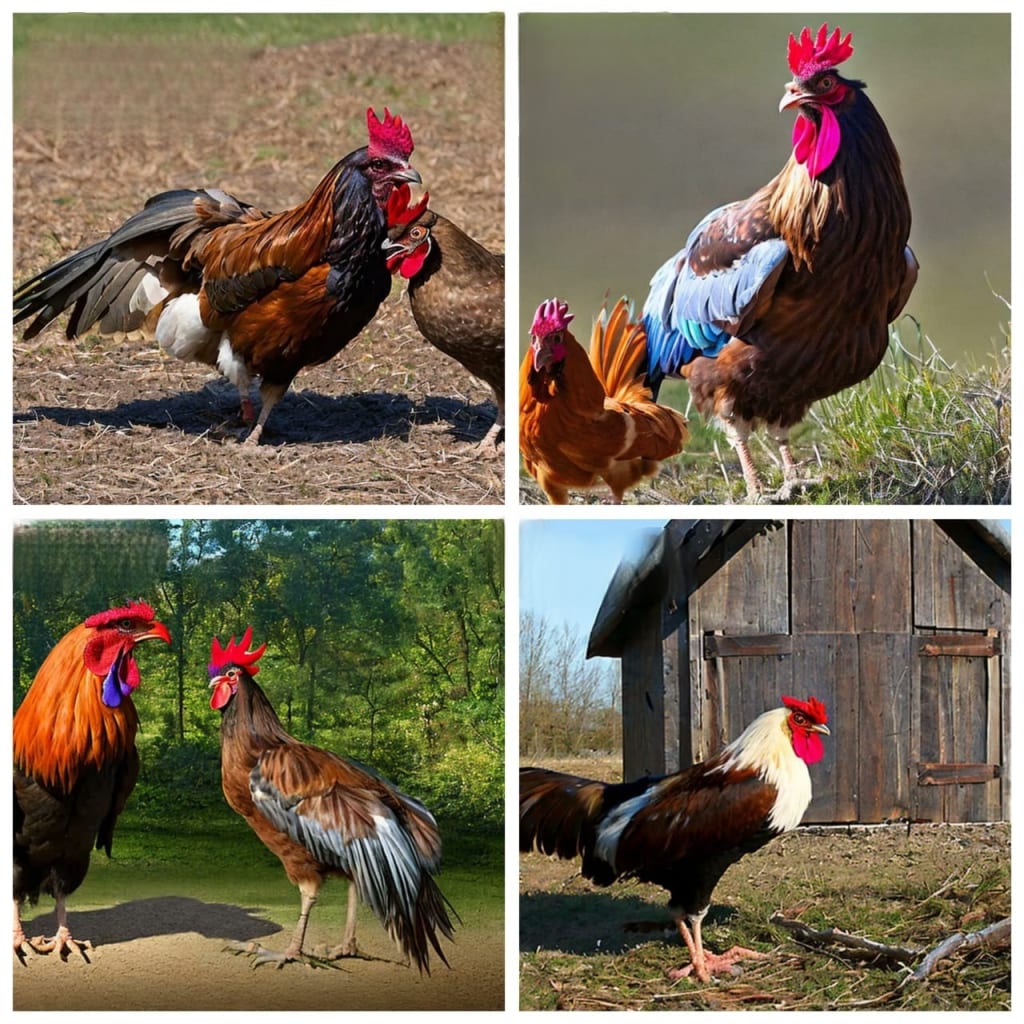The Art of Cockfighting: Exploring Different Types of Fighting Cocks
Different Types of Fighting Cocks

The Art of Cockfighting: Exploring Different Types of Fighting Cocks
Outline of the Article
1. Introduction
2. History of Cockfighting
2.1 Origins of Cockfighting
2.2 Spread of Cockfighting
3. Different Breeds of Fighting Cocks
3.1 American Gamefowl
3.2 Shamo
3.3 Thai Gamefowl
3.4 Malay Game
3.5 Asil
3.6 Other Breeds
4. Training and Conditioning
4.1 Selection of Birds
4.2 Feeding and Nutrition
4.3 Exercise and Conditioning
5. The Cockfighting Culture Around the World
5.1 Cockfighting Regulations and Legal Status
5.2 Cockfighting in Asia
5.3 Cockfighting in Latin America
5.4 Cockfighting in the United States
6. Ethical Concerns and Opposition to Cockfighting
6.1 Animal Cruelty and Welfare Issues
6.2 Legal Challenges and Bans
7. The Future of Cockfighting
7.1 Modernization and Technology
7.2 Shifting Attitudes and Practices
8. Conclusion
The world of cockfighting is a fascinating and controversial one, steeped in history and cultural significance. This article aims to provide an in-depth exploration of different types of fighting cocks, shedding light on their origins, breeds, training methods, and the cultural context in which cockfighting takes place. Join us on this journey as we delve into the art and complexities of cockfighting.
1. Introduction
Cockfighting is a centuries-old blood sport where two specially bred roosters, known as fighting cocks, engage in a battle of strength, skill, and strategy. While controversial and banned in many countries, cockfighting remains deeply ingrained in the cultural fabric of certain regions. This article will provide a comprehensive overview of the subject, shedding light on the different breeds of fighting cocks and the nuances of this ancient sport.
2. History of Cockfighting
2.1 Origins of Cockfighting
Cockfighting traces its roots back to ancient times, with evidence of its existence in various civilizations, including ancient Greece, Rome, and Southeast Asia. The precise origins are debated, but it is believed that the sport originated independently in multiple cultures.
2.2 Spread of Cockfighting
Over the centuries, cockfighting spread to different parts of the world through exploration, trade, and colonization. The sport evolved and adapted, integrating with local traditions and breeding practices.
3. Different Breeds of Fighting Cocks
There are numerous breeds of fighting cocks, each with its distinct characteristics and fighting styles. Here are some notable breeds:
3.1 American Gamefowl
The American Gamefowl is a breed renowned for its aggression, strength, and endurance. It has been bred selectively for cockfighting purposes and has become highly prized in the sport.
3.2 Shamo
Originating from Japan, the Shamo breed is known for its size and strength. These birds have a fierce fighting spirit and are highly sought after by enthusiasts.
3.3 Thai Gamefowl
Thai Gamefowl, also known as Thai roosters, are revered for their agility, intelligence, and deadly fighting skills. They have a rich history in the sport, and their distinct appearance makes them a favorite among cockfighting enthusiasts.
3.4 Malay Game
Malay Game, originating from Southeast Asia, is a breed known for its tall and slender stature. These birds possess incredible strength and striking abilities, making them formidable opponents in the cockfighting arena.
3.5 Asil
Asil, also known as Aseel or Asli, is an ancient breed originating from India and Pakistan. They are highly prized for their strength, endurance, and unwavering fighting spirit. Asil roosters display an elegant and distinctive appearance.
3.6 Other Breeds
In addition to the aforementioned breeds, there are numerous other fighting cock breeds across the world. These include the Brazilian Game, Cubalaya, Spanish Game, and many more. Each breed brings its unique characteristics and traits to the world of cockfighting.
4. Training and Conditioning
To maximize their performance in the cockpit, fighting cocks undergo rigorous training and conditioning. Here are some essential aspects of preparing these birds for battle:
4.1 Selection of Birds
The selection of fighting cocks is a crucial step in the training process. Experienced breeders carefully assess various factors such as physical attributes, temperament, and bloodline to identify potential champions.
4.2 Feeding and Nutrition
Proper nutrition plays a vital role in the development and overall health of fighting cocks. A well-balanced diet rich in protein, vitamins, and minerals is essential to optimize their physical condition and stamina.
4.3 Exercise and Conditioning
Regular exercise and conditioning are key to enhancing a fighting cock's strength, agility, and endurance. Activities such as flying, sparring, and running help build muscle, improve reflexes, and increase cardiovascular fitness.
5. The Cockfighting Culture Around the World
Cockfighting has a rich cultural heritage in various parts of the world, but its legal status and cultural acceptance vary significantly. Let's explore the cockfighting culture in different regions:
5.1 Cockfighting Regulations and Legal Status
Cockfighting is prohibited in many countries due to concerns about animal welfare and cruelty. However, in certain regions, it remains legal under strict regulations and licensing.
5.2 Cockfighting in Asia
Asia, particularly countries like the Philippines, Thailand, and Indonesia, has a deep-rooted tradition of cockfighting. It is often considered a part of cultural festivals and attracts passionate enthusiasts who participate in organized competitions.
5.3 Cockfighting in Latin America
In countries like Mexico, Puerto Rico, and the Dominican Republic, cockfighting holds cultural significance and continues to thrive despite legal restrictions. These nations have a robust cockfighting scene with dedicated arenas and a passionate community.
5.4 Cockfighting in the United States
Cockfighting is illegal in all 50 states of the United States, with federal laws prohibiting the practice. However, some areas, such as Puerto Rico and Guam, have exemptions, allowing limited cockfighting activities.
6. Ethical Concerns and Opposition to Cockfighting
The practice of cockfighting has faced significant opposition from animal rights organizations and individuals who perceive it as cruel and inhumane. Here are some key ethical concerns and arguments against the sport:
6.1 Animal Cruelty and Welfare Issues
Opponents argue that cockfighting subjects the birds to unnecessary pain, suffering, and potential injury. They claim that the breeding, training, and fighting conditions are detrimental to the well-being of the roosters involved.
6.2 Legal Challenges and Bans
Due to the concerns surrounding animal welfare, many countries and jurisdictions have implemented strict bans on cockfighting. Legal challenges and public pressure have contributed to the decline of the sport in certain areas.
7. The Future of Cockfighting
As societal attitudes evolve and animal welfare concerns gain prominence, the future of cockfighting faces uncertainty. However, several factors may influence the direction the sport takes:
7.1 Modernization and Technology
Advancements in technology, such as virtual reality and e-sports, provide alternative avenues for competitive gaming experiences. These innovations could potentially shift the focus away from traditional cockfighting.
7.2 Shifting Attitudes and Practices
Changing social norms and increased awareness of animal welfare may prompt a shift in cultural acceptance of cockfighting. Efforts to promote alternative forms of entertainment and animal-friendly activities may further impact the future of the sport.
8. Conclusion
Cockfighting is an ancient and controversial practice that continues to captivate enthusiasts around the world. This article has explored the different breeds of fighting cocks, training methods, the cultural context of cockfighting, ethical concerns, and the future of the sport. Whether viewed as an art form, a cultural tradition, or a form of animal cruelty, cockfighting remains a subject of debate and scrutiny.
FAQs (Frequently Asked Questions)
1. Is cockfighting legal anywhere in the world?
While cockfighting is illegal in many countries, there are still regions where it remains legal under specific regulations and licensing.
2. Are all fighting cocks aggressive by nature?
Fighting cocks are selectively bred for their aggressive tendencies and fighting instincts, but individual temperament may vary.
3. What are the risks associated with cockfighting?
Cockfighting poses risks to the birds involved, including injuries, infections, and stress. It also faces legal consequences in many jurisdictions.
4. Are there alternative forms of entertainment related to cockfighting?
Yes, some countries have embraced alternative forms of entertainment, such as chicken beauty contests and bird exhibitions, as more humane alternatives.
5. How can one support animal welfare while preserving cultural traditions?
Balancing animal welfare concerns with cultural traditions requires open dialogue, education, and exploring alternative practices that promote both ethical treatment and cultural preservation.
About the Creator
Ghulam Abbas
Skilled content writer with 15 years' experience in humanities and motivation. Illuminating insights in literature, history, philosophy, and culture, connecting readers to human experiences. Expertise in motivational writing.





Comments
There are no comments for this story
Be the first to respond and start the conversation.